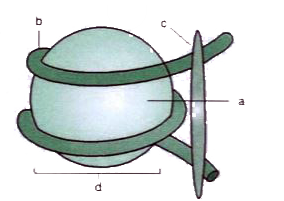Name any annelid which is dioecious
(a) Pheretina
(b) Eisenia
(c) Nereis
(d) Lumbricus
Pheretina Eisensia
Eisenia
Nereis
Lumbricus
The correct Answer is:C
To solve the question of identifying a dioecious annelid from the given options, we can follow these steps:
1. Understand the Term Dioecious:
- Dioecious organisms are those that have distinct male and female individuals. This means that a dioecious species will have individuals that are either male or female, but not both.
2. Analyze the Given Options:
- The options provided are:
(a) Pheretina
(b) Eisenia
(c) Nereis
(d) Lumbricus
3. Evaluate Each Option:
- Pheretina: This organism is known to be monoecious (hermaphroditic), meaning it has both male and female reproductive structures.
- Eisenia: Similar to Pheretina, Eisenia is also monoecious and possesses both male and female reproductive organs.
- Nereis: Nereis is known to be dioecious, meaning it has separate male and female individuals.
- Lumbricus: This organism is also monoecious and has both male and female reproductive structures.
4. Identify the Correct Answer:
- From the analysis, the only organism that is dioecious is Nereis. Therefore, the correct answer to the question is option (c) Nereis.
Final Answer:
The annelid that is dioecious is (c) Nereis.
---
- Dioecious organisms are those that have distinct male and female individuals. This means that a dioecious species will have individuals that are either male or female, but not both.
- The options provided are:
(a) Pheretina
(b) Eisenia
(c) Nereis
(d) Lumbricus
- Pheretina: This organism is known to be monoecious (hermaphroditic), meaning it has both male and female reproductive structures.
- Eisenia: Similar to Pheretina, Eisenia is also monoecious and possesses both male and female reproductive organs.
- Nereis: Nereis is known to be dioecious, meaning it has separate male and female individuals.
- Lumbricus: This organism is also monoecious and has both male and female reproductive structures.
- From the analysis, the only organism that is dioecious is Nereis. Therefore, the correct answer to the question is option (c) Nereis.
The annelid that is dioecious is (c) Nereis.
Topper's Solved these Questions
- PHYLUM - ANNELIDABOOK - DINESH PUBLICATION ENGLISHCHAPTER - PHYLUM - ANNELIDAEXERCISE - Revision Question From Compretitive Exams.
38 Videos
- PHYLUM - ANNELIDABOOK - DINESH PUBLICATION ENGLISHCHAPTER - PHYLUM - ANNELIDAEXERCISE - Check your grasp
10 Videos
- PHOTOSYNTHESISBOOK - DINESH PUBLICATION ENGLISHCHAPTER - PHOTOSYNTHESISEXERCISE - CYG
10 Videos
- PHYLUM - ARTHROPODABOOK - DINESH PUBLICATION ENGLISHCHAPTER - PHYLUM - ARTHROPODAEXERCISE - CYG
20 Videos
Similar Questions
In which animal gonads develop only during breeding season?
(a) Pheretima
(b) Lumbricus
(c) Nereis
(d) Hirudo
View SolutionFunaria is
(a) Heteroecious
(b) Dioecious
(c) Monoecious
(d) Trioecious
View SolutionName any two disaccharides which involve B-linkages.
View SolutionName the quantity which is measured in
(a) kWh (b)kW (c )Wh (d)eV
View SolutionLocomotion occurs in Sandworm or Nereis through
(a) Chaetae
(b) Setae
(c) Legs
(d) Parapodia
View SolutionAnnelids have a central nerve cord which is
(a) Hollow
(b) Impermeable to K + ions
(c) Dorsal
(d) Ventral
View SolutionThe segmental appendages of Nereis are
(a) Tentacles
(b) Setae
(c) Suckers
(d) Parapodia
View SolutionExcretory system is absent in
(a) Echinodermata
(b) Mollusca
(c) Annelids
(d) Arthropods
View SolutionEnvironment determines the sex of the animal in
(A) Bonellia
(B) Hirudinaria
(C) Nereis
(D) Both A and B
View Solution
Name the parts a, b, c and d.
View Solution
